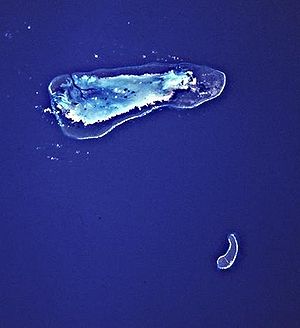Aldabra
| UNESCO World Heritage Site | |
|---|---|
 | |
| Criteria | Natural: vii, ix, x |
| Reference | 185 |
| Inscription | 1982 (6th Session) |
Aldabra, the world's largest coral atoll, is in the Aldabra Group of islands in the Indian Ocean that form part of the Seychelles. Uninhabited and extremely isolated Aldabra is virtually untouched by humans, has distinctive island fauna including the Aldabra Giant Tortoise, and is designated a World Heritage Site.
History

Aldabra was visited by Portuguese navigators in 1511. The islands were already known to the Arabs, from whom they get their name. In the middle of the 18th century, they became dependencies of the French colony of Réunion, from where expeditions were made for the capture of the giant tortoises. In 1810 with Mauritius, Réunion, the Seychelles and other islands, Aldabra passed into the possession of Great Britain. Réunion was returned to France, and Mauritius gained possession of Aldabra as well as the rest of the Seychelles. The previous inhabitants were emigrants from the Seychelles. Sailors landed on the atoll in the 19th century and attempted to raid the island for tortoises as food; in 1842, two ships were reported to have taken 1200 of them. By 1900, the tortoises were nearly extinct, and a crew would often have to hunt for three days to find one.[1]
The Aldabra Atoll, along with Des Roches and Farquhar, was part of the British Indian Ocean Territory from 1965 until Seychelles independence in 1976. In the 1960s, the British considered allowing the United States to use the island as home for a military air base. After an international protest by ecologists, however, the military plans were abandoned and the wildlife habitat instead received full protection.[2] Aldabra was designated a World Heritage Site on November 19, 1982, and is administered from Mahé by the Seychelles Island Foundation.[3]
The abandoned settlement Picard on the southwestern tip of West Island is now home to the Research Officer, Island Manager and their rangers and staff. There is no other permanent population.
Geography


The island is more than 700 miles from Mahé, the principal island of the Seychelles and is closer to the coast of Africa and is 265 miles northwest of Madagascar and a similar distance northeast from the Comoro Islands. The atoll is located at 9°24′S 46°22′E / 9.400°S 46.367°E and belongs to the Aldabra Group, one of the island groups of the Outer Islands of the Seychelles, which includes the island of Assumption and the atolls of Astove and Cosmoledo. [4]
The atoll is the second largest in the world after Kiritimati. It is 34 km long, 14.5 km wide, up to 8 meters above sea level, and has a land area of 155.4 km². The lagoon measures 224 km² in area, of which roughly two thirds fall dry during low tide. The atoll consists of a ring of four larger islands: counterclockwise, they are South Island (Grand Terre, 116.1 km²), Malabar or Middle Island (26.8 km), Polymnieli or Polymnie Island (4.75 km²) and Picard or West Island (9.4 km²).

Additionally, there are some forty smaller islands and rocks, all inside the lagoon, except a few very small islets at the West Channels between South and Polymnie Islands, the largest of those being Îlot Magnan. The largest islands inside the lagoon are Île Michel (Coconut Island), in the east (0.34 km² or 0.16 sq.mi.) and Île Esprit (Euphrates Island), in the west (0.41 km² 0.13 sq.mi.).
The islands consist of limestone uplands, sand dunes and beaches based on the remains of a coral reef.
Flora
Aldabra has a number of endemic plant species. The higher areas are covered in species of pemphis, thick coastal shrubs, while the lower areas which are home to the giant tortoises, are a mixture of trees, shrubs, herbs and grasses.
Fauna
The atoll is home to the world's largest population of giant tortoises, the Aldabra Giant Tortoise (Dipsochelys dussumieri), numbering some 150,000 individuals.[5] They are also known for their Coconut crab (Birgus latro), the world's largest land crab, and hammerhead sharks, manta rays, barracuda and as a breeding ground for green turtles and hawksbill turtles. Birds of Aldabra include the Aldabra rail, the last surviving flightless bird of the Indian Ocean region, and the endangered Malagasy Sacred Ibis as well as large numbers of nesting seabirds.
See also
- Addyaita - a giant turtle of Aldabra. It was at least 250-years old when it died at Kolkata (formerly Calcutta) Zoo on March 24, 2006.
- Geography of Seychelles
References
- ^ Carpin, Sarah,(1998) Seychelles, Odyssey Guides, p.162, The Guidebook Company Limited, Retrieved on June 22, 2008
- ^ Carpin, Sarah,(1998) Seychelles, Odyssey Guides, p.162, The Guidebook Company Limited, Retrieved on June 22, 2008
- ^ Seychelles Islands Foundation, Retrieved on June 22, 2008
- ^ Carpin, Sarah,(1998) Seychelles, Odyssey Guides, p.161, The Guidebook Company Limited, Retrieved on June 22, 2008
- ^ Payne, Roger (2004-04-05). "Losing Aldabra". Voyage of the Odyssey. PBS. Retrieved 2008-10-21.
{{cite web}}: Cite has empty unknown parameter:|coauthors=(help)
External links
- Aldabra at the Ministry of Environment, Seychelles
- Aldabra at the Seychelles Islands Foundation
- Aldabra Marine Programme
- Aldabra Atoll at the UNESCO World Heritage Site
- "Expedition Aldabra" (Gordon, Ethan, Fathoms Online, Issue #8)
- Photos of Aldabran wildlife
- Aldabra Island xeric scrub (World Wildlife Fund)
- UNESCO Natural Site Data Sheet
- Save Our Seas Foundation Promotional Video for Aldabra
- Pictures of Russian Robinson Radio expedition to Aldabra
List of smaller islands in the lagoon
|
|
|
